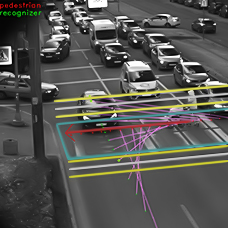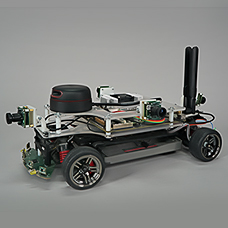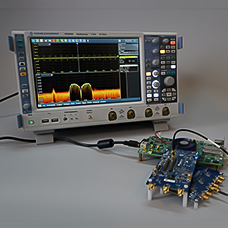Video analytics systems
Development of algorithms and software for the intellectual analysis of digital images in the field of video surveillance and security: recognition, detection, visualization of objects or panoramas, analysis and image search, etc.

Related technologies
- Machine learning
- Internet of things
Scope of applicability
Video Surveillance and SecurityTasks
- Analysis of a large number of objects
- Continuous operation without loss of quality
- High speed and accuracy of measurements
- Automatic image analysis
- Automatic decision-making
- Performance of additional functions as the task may require
Advantages
- Improving the speed and quality of control by eliminating the “human factor”
- multitask capability (detection, classification, automated decision-making, matching search, etc.)
- Reduction of labor costs and other costs of traditional verification methods
- Guaranteed detection of emergencies and violators; the database search option.
Our project approach
We develop algorithms and software for processing video streams and images to solve a wide range of tasks, depending on the application area and the customer’s goals. A separate area is the development and optimization of software solutions for embedded systems with limited computing capacities.Technical vision systems
Intelligent analysis of digital images from industrial cameras to improve the accuracy and efficiency of equipment and processes, often used as a component of larger systems and focused on specific application tasks.

Related technologies
- Machine learning
- Industrial Internet of Things
Scope of applicability
- Video Surveillance
- Industrial automation
- Robotics
- Vehicle control systems
- Medical information systems
Tasks
- Analysis of a large number of objects
- Continuous operation without loss of quality
- High speed
- High measurement accuracy
- Automation of verification and control
Advantages
- Improving the speed and quality of control
- Stable quality due to the exclusion of the “human factor”
- Multi-task capability (detection, classification, identification of objects, automated decision-making, etc.)
- Reduction of labor costs and other costs on traditional verification methods
- Optimization of business processes and guarantee of their effectiveness
Our project approach
We carry out a full cycle of hardware and software development; develop and adapt machine vision algorithms to the performance targets. Orientation to the target software and hardware platform improves the performance of algorithms. In the development, we use machine- learning and deep-learning approaches.Multisensory systems, IIoT
We develop systems for collecting, transmitting and analyzing data from transmitters and sensors for integrated control of equipment and processes. As “input devices” of primary information, video cameras, gyro sensors, barometers, sound, temperature, and pressure sensors, etc. are used. “Dark” data are conveyed to a cloud computing service for interpretation and analysis. The result is visualized on the cameraman's workstation in the form of formalized data on the status of key processes.

Related technologies
- Machine learning
- Internet of things
Scope of applicability
It is used in production, in the operation of critically important engineering structures (pipelines and gas pipes) in difficult for access conditions, wherever comprehensive monitoring of equipment or processes is required.
Tasks
- Collection and processing of a large amount of heterogeneous data
- “Instant cut” of information simultaneously throughout the system
- Continuous monitoring of key parameters in the real-time mode
- The possibility to optimize system management using additional functions of analytics including the predictive one.
Advantages
- Enhancement of the quality and effectiveness of monitoring of the state of objects
- Ability to control the operation process using forecasts and recommendations
- Capacity to prevent critical situations before they take place
- Reduction of time and financial costs for traditional control methods
- Reducing the costs of operating and repairing the system
Our project approach
- Solving complex engineering problems in the development of data-acquisition units with special requirements for the performance, accuracy, cost, energy consumption, etc.
- Development of intelligent embedded software for preprocessing, data compression, and optimization of equipment operating modes
- Enhancement of the speed of data collection and transmission processes based on boundary computing: data processing is performed not in the data center, but directly on the IIoT monitoring devices.
Machine learning technologies
A system for collecting and processing data on the state of equipment or processes based on mathematical models and algorithms that allow to build predictive analytics based on historical data on the system functioning.

Related technologies
- Technical vision systems
- Video analytics systems
- Internet of things
Scope of applicability
Banking, IT, retail, industry, logistics, agriculture and crop production.Tasks
- Monitoring the status of equipment and processes
- immediate interpretation of large amounts of data
- Decision-making support
- Forecast of emergencies, reduction of risks
- Assistance in solving applied problems
Advantages
- Improving the efficiency of parameter monitoring
- Reduction of the decision-making time
- Reduction of the number of emergencies due to their forecasting
- Reduction of the equipment repair and maintenance costs
- Identification of bottlenecks and optimization of business processes for the increase of the rate and efficiency of the company’s operation
- Development focused on the application tasks of a particular company
Our project approach
We use a wide range of machine learning algorithms to achieve customer goals: from decision trees to ultra-precise neural networks. We have rich experience in the work on the analysis of the video stream using machine learning algorithms. If you need to implement solutions on embedded platforms, we transfer resource-intensive solutions to platforms with limited computing capacities.